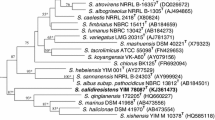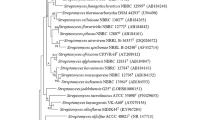Abstract
A novel actinobacterium, designated MM109T, was isolated from a moonmilk deposit collected from the cave ‘Grotte des Collemboles’ located in Comblain-au-Pont, Belgium. Based on a polyphasic taxonomic approach comprising chemotaxonomic, phylogenetic, morphological, and physiological characterization, the isolate has been affiliated to the genus Streptomyces. Multilocus sequence analysis based on the 16S rRNA gene and five other house-keeping genes (atpD, gyrB, rpoB, recA and trpB) showed that the MM109T isolate is sufficiently distinct from its closest relative, Streptomyces peucetius strain AS 4.1799T, as to represent a novel species. The phylogenetic distinctiveness of the taxon represented by isolate MM109T was supported by the isolation and identification of additional twelve moonmilk-derived isolates, which according to multilocus sequence analysis were clustered along with MM109T. Scanning electron microscopy observations revealed complex and diversified structures within a MM109T colony, made from branching vegetative mycelia. The spore chains of the MM109T isolate undergo complete septation at the late stages of the morphological differentiation process, leading to the formation of packs of smooth cylindrical-shaped spores. Isolate MM109T produces several intracellular and diffusible pigments, particularly an intracellular green-pigmented secondary metabolite, which was identified through UPLC-ESI–MS analysis as ferroverdin A, an iron-chelating molecule formerly extracted and characterized from Streptomyces sp. strain WK-5344. The isolate MM109T is thus considered to represent a novel species of Streptomyces, for which the name Streptomyces lunaelactis sp. nov. is proposed with the type strain MM109T (=DSM 42149T = BCCM/LMG 28326T).





Similar content being viewed by others
References
Barton HA, Northup DE (2007) Geomicrobiology in cave environments: past, current and future prospectives. J Cave Karst Stud 69:163–178
Barton HA, Taylor NM, Kreate MP, Springer AC, Oehrle SA, Bertog JL (2007) The impact of host rock geochemistry on bacterial community structure in oligotrophic cave environments. Int J Speleol 36:93–104
Bertram R, Schlicht M, Mahr K, Nothaft H, Saier MH Jr, Titgemeyer F (2004) In silico and transcriptional analysis of carbohydrate uptake systems of Streptomyces coelicolor A3(2). J Bacteriol 186:1362–1373
Busarakam K, Bull AT, Girard G, Labeda DP, van Wezel GP, Goodfellow M (2014) Streptomyces leeuwenhoekii sp. nov., the producer of chaxalactins and chaxamycins, forms a distinct branch in Streptomyces gene trees. Antonie Van Leeuwenhoek 105:849–861
Canaveras JC, Cuezva S, Sanchez-Moral S, Lario J, Laiz L, Gonzalez JM, Saiz-Jimenez C (2006) On the origin of fiber calcite crystals in moonmilk deposits. Naturwissenschaften 93:27–32. doi:10.1007/s00114-005-0052-3
Corpet F (1988) Multiple sequence alignment with hierarchical clustering. Nucleic Acids Res 16:10881–10890
Cuezva S et al (2012) The biogeochemical role of Actinobacteria in Altamira Cave, Spain. FEMS Microbiol Ecol 81:281–290. doi:10.1111/j.1574-6941.2012.01391.x
Davis NK, Chater KF (1990) Spore colour in Streptomyces coelicolor A3(2) involves the developmentally regulated synthesis of a compound biosynthetically related to polyketide antibiotics. Mol Microbiol 4:1679–1691
Edgar RC (2004) MUSCLE: multiple sequence alignment with high accuracy and high throughput. Nucleic Acids Res 32:1792–1797. doi:10.1093/nar/gkh340
Felsenstein J (1981) Evolutionary trees from DNA sequences: a Maximum Likelihood Approach. J Mol Evol 17:368–376
Felsenstein J (1985) Confidence limits on phylogenies: an approach using the bootstrap. Evolution 39:783–791
Gartner A, Blumel M, Wiese J, Imhoff JF (2011) Isolation and characterisation of bacteria from the Eastern Mediterranean deep sea. Antonie Van Leeuwenhoek 100:421–435. doi:10.1007/s10482-011-9599-5
Goodfellow M, Kampfer P, Busse HJ, Trujillo ME, Suzuki K-I, Ludwig W, Whitman WB (2012) The Actinobacteria, Parts A and B vol 5. Bergey’s Manual of Systematic Bacteriology. Springer, New York
Grein A, Spalla C, Di Marco A, Canevazzi G (1963) Descrizione e classificazione di un attinomicete (Streptomyces peucetius sp. nova) produttore di una sostanza attivita antitumorale: La daunomicina. G Microbiol 11:109–118
Guo Y, Zheng W, Rong X, Huang Y (2008) A multilocus phylogeny of the Streptomyces griseus 16S rRNA gene clade: use of multilocus sequence analysis for streptomycete systematics. Int J Syst Evol Microbiol 58:149–159. doi:10.1099/ijs.0.65224-058/1/149
Han JH, Cho MH, Kim SB (2012) Ribosomal and protein coding gene based multigene phylogeny on the family Streptomycetaceae. Syst Appl Microbiol 35:1–6. doi:10.1016/j.syapm.2011.08.007
Hodgson DA (2000) Primary metabolism and its control in streptomycetes: a most unusual group of bacteria. Adv Microb Physiol 42:47–238
Hopwood DA (2007) Streptomyces in nature and medicine—the antibiotic makers. Oxford University Press, New York
Kämpfer P (2012) Genus I. Streptomyces Waksman and Henrici 1943, 339 emend. Witt and Stackebrandt 1990, 370 emend. Wellington, Stackebrandt, Sanders, Wolstrup and Jorgensen 1992, 159. In: Goodfellow M, Kämpfer P, Busse H-J, Trujillo ME, Suzuki K-I, Ludwig W, Whitman WB vol 5. The Actinobacteria, Part B. 2., Bergey’s Manual of Systematic Bacteriology edn. Springer, New York
Kelly KL (1964) Inter-Society Color Council—National Bureau of Standards Color Name Charts Illustrated with Centroid Colors. US Government Printing Office, Washington
Kieser T, Bibb MJ, Buttner MJ, Chater KF, Hopwood DA (2000) Practical Streptomyces Genetics. John Innes Foundation, Norwich
Kim OS, Cho YJ, Lee K, Yoon SH, Kim M, Na H, Park SC, Jeon YS, Lee JH, Yi H, Won S, Chun J (2012) Introducing EzTaxon: a prokaryotic 16S rRNA Gene sequence database with phylotypes that represent uncultured species. Int J Syst Evol Microbiol 62:716–721
Kimura M (1980) A simple method for estimating evolutionary rates of base substitutions through comparative studies of nucleotide sequences. J Mol Evol 16:111–120
Kroppenstedt RM (1985) Fatty acid and menaquinone analysis of actinomycetes and related organisms. Chem Methods Bact Syst 20:173–199
Kuykendall LD, Roy MA, O’Neill JJ, Devine TE (1988) Fatty acids, antibiotic resistance, and deoxyribonucleic acid homology groups of Bradorhizobium japonicum. Int J Syst Bacteriol 38:358–361
Labeda DP (2011) Multilocus sequence analysis of phytopathogenic species of the genus Streptomyces. Int J Syst Evol Microbiol 61:2525–2531. doi:10.1099/ijs.0.028514-0
Labeda DP, Doroghazi JR, Ju KS, Metcalf WW (2014) Taxonomic evaluation of Streptomyces albus and related species using multilocus sequence analysis and proposals to emend the description of Streptomyces albus and describe Streptomyces pathocidini sp. nov. Int J Syst Evol Microbiol 64:894–900
Lambert S et al (2014) Altered desferrioxamine-mediated iron utilization is a common trait of bald mutants of Streptomyces coelicolor. Metallomics 6:1390–1399
Lechevalier MP, Lechevalier H (1970) Chemical composition as a criterion in the classification of aerobic actinomycetes. Int J Syst Bacteriol 20:435–443
Lechevalier MP, De Bie`vre C, Lechevalier HA (1977) Chemotaxonomy of aerobic actinomycetes: phospholipid composition. Biochem Syst Ecol 5:249–260
Leyh-Bouille M, Bonaly R, Ghuysen JM, Tinelli R, Tipper D (1970) LL-Diaminopimelic acid containing peptidoglycans in walls of Streptomyces sp. and of Clostridium perfringens (type A). Biochemistry 9:2944–2952
Manfio GP, Zakrzewska-Czerwinska J, Atalan E, Goodfellow M (1995) Towards minimal standards for the description of Streptomyces species. Biotekhnologia 7–8:242–253
Miller LT (1982) Single derivatization method for routine analysis of bacterial whole-cell fatty acid methyl esters, including hydroxy acids. J Clin Microbiol 16:584–586
Murase M, Hikiji T, Nitta K, Okami Y, Takeuchi T, Umezawa H (1961) Peptimycin, a product of Streptomyces exhibiting apparentinhibition against Ehrlich carcinoma. J Antibiot Ser A 14:113–118
Noens EE, Mersinias V, Traag BA, Smith CP, Koerten HK, van Wezel GP (2005) SsgA-like proteins determine the fate of peptidoglycan during sporulation of Streptomyces coelicolor. Mol Microbiol 58:929–944
Onstott TC et al (2009) Microbial communities in subpermafrost saline fracture water at the Lupin Au mine, Nunavut, Canada. Microb Ecol 58:786–807. doi:10.1007/s00248-009-9553-5
Ortiz M, Legatzki A, Neilson JW, Fryslie B, Nelson WM, Wing RA (2014) Making a living while starving in the dark: metagenomic insights into the energy dynamics of a carbonate cave. ISME J 8:478–491
Porca E, Jurado V, Žgur-Bertok D, Saiz-Jimenez C, Pašić L (2012) Comparative analysis of yellow microbial communities growing on the walls of geographically distinct caves indicates a common core of microorganisms involved in their formation. FEMS Microbiol Ecol 81:255–266
Portillo MC, Saiz-Jimenez C, Gonzalez JM (2009) Molecular characterization of total and metabolically active bacterial communities of ‘white colonizations’ in the Altamira Cave, Spain. Res Microbiol 160:41–47
Rong X, Huang Y (2010) Taxonomic evaluation of the Streptomyces griseus clade using multilocus sequence analysis and DNA–DNA hybridization, with proposal to combine 29 species and three subspecies as 11 genomic species. Int J Syst Evol Microbiol 60:696–703
Rong X, Huang Y (2012) Taxonomic evaluation of the Streptomyces hygroscopicus clade using multilocus sequence analysis and DNA–DNA hybridization, validating the MLSA scheme for systematics of the whole genus. Elsevier 35:7–18
Rong X, Guo Y, Huang Y (2009) Proposal to reclassify the Streptomyces albidoflavus clade on the basis of multilocus sequence analysis and DNA–DNA hybridization, and taxonomic elucidation of Streptomyces griseussubsp.solvifaciens. Syst Appl Microbiol 32:314–322
Saitou N, Nei M (1987) The neighbor-joining method: a new method for reconstructing phylogenetic trees. Mol Biol Evol 4:406–425
Shirling EB, Gottlieb D (1966) Methods for characterization of Streptomyces species. Int J Syst Bacteriol 16:313–340
Staneck JL, Roberts GD (1974) Simplified approach to identification of aerobic actinomycetes by thin-layer chromatography. Appl Microbiol 28:226–231
Tabata N, Tomoda H, Omura S (1999) Ferroverdins, inhibitors of cholesteryl ester transfer protein produced by Streptomyces sp. WK-5344, II. Structure elucidation. J Antibiot 52:1108–1113
Tamura K, Stecher G, Peterson D, Filipski A, Kumar S (2013) MEGA6: Molecular Evolutionary Genetics Analysis Version 6.0. Mol Biol Evol 30:2725–2729
Tenconi E, Jourdan S, Motte P, Virolle MJ, Rigali S (2012) Extracellular sugar phosphates are assimilated by Streptomyces in a PhoP-dependent manner. Antonie Van Leeuwenhoek 102:425–433
Tetu SG, Breakwell K, Elbourne LD, Holmes AJ, Gillings MR, Paulsen IT (2013) Life in the dark: metagenomic evidence that a microbial slime community is driven by inorganic nitrogen metabolism. The ISME journal 7:1227–1236
Tindall BJ (1990a) A comparative study of the lipid composition of Halobacterium saccharovorum from various sources. Syst Appl Microbiol 13:128–130
Tindall BJ (1990b) Lipid composition of Halobacterium lacusprofundi. FEMS Microbiol Letts 66:199–202
Tindall BJ, Sikorski J, Smibert RM, Kreig NR (2007) Phenotypic characterization and the principles of comparative systematics. In methods for general and molecular microbiology, 3rd edn. ASM Press, Washington, pp 330–393
Tomoda H, Tabata N, Shinose M, Takahashi Y, Woodruff HB, Omura S (1999) Ferroverdins, inhibitors of cholesteryl ester transfer protein produced by Streptomyces sp. WK-5344. I. Production, isolation and biological properties. J Antibiot 52:1101–1107
Waksman SA (1961) The actinomycetes, classification, identification and description of genera and species, vol 2. Williams & Wilkins, Baltimore
Waksman SA (1967) The Actinomycetes. Ronald Press, A Summary of Current Knowledge. New York
Xu P et al (2005) Naxibacter alkalitolerans gen. nov., sp nov., a novel member of the family ‘Oxalobacteraceae’ isolated from China. Int J Syst Evol Microbiol 55:1149–1153
Zlatkin IV, Schneider M, de Bruijn FJ, Forney LJ (1996) Diversity among bacteria isolated from the deep subsurface. J Ind Microbiol 17:219–227
Acknowledgments
MM, and ISP work is supported by a Research Foundation for Industry and Agriculture (FRIA) grant. SR is a research associate at Belgian Funds for Scientific Research (F.R.S-FNRS). AAA work is supported by a F.R.S-FNRS grant (R.FNRS.3342). This work is supported in part by the Belgian program of Interuniversity Attraction Poles initiated by the Federal Office for Scientific Technical and Cultural Affairs (PAI no. P7/44). We are thankful to Prof Denis Baurain (ULg) and Maxime Licops for useful advices for our phylogeny analyses and technical assistance, respectively.
Conflict of Interest
None.
Author information
Authors and Affiliations
Corresponding author
Electronic supplementary material
Below is the link to the electronic supplementary material.
Rights and permissions
About this article
Cite this article
Maciejewska, M., Pessi, I.S., Arguelles-Arias, A. et al. Streptomyces lunaelactis sp. nov., a novel ferroverdin A-producing Streptomyces species isolated from a moonmilk speleothem. Antonie van Leeuwenhoek 107, 519–531 (2015). https://doi.org/10.1007/s10482-014-0348-4
Received:
Accepted:
Published:
Issue Date:
DOI: https://doi.org/10.1007/s10482-014-0348-4




